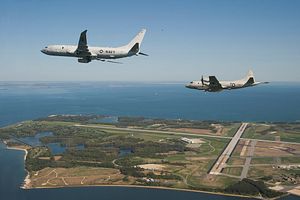New Zealand is expected to make a decision over the purchase of four U.S.-made Boeing P-8A Poseidon maritime patrol aircraft, the biggest and most expensive defense procurement for the New Zealand Defense Force (NZDF) in recent years, by the end July, according to local media reports.
The new P-8A Poseidon maritime patrol aircraft are expected to replace the Royal New Zealand Air Force’s (RNZAF) current fleet of six P-3K2 Orion maritime patrol aircraft under the RNZAF’s so-called Future Air Surveillance Capability project by 2025.
Boeing scored a $24.1 million contract for the upgrade of the six P-3K2 Orions in April 2016. The upgrades include a new underwater intelligence, surveillance, and reconnaissance capability package, which boosts the aircraft’s anti-submarine warfare capabilities.
“The aircraft and their sensors have been upgraded several times but they are now beyond further upgrades,” according to a Ministry of Defense and NZDF analysis. As I wrote in May 2017:
While the upgrade will temporarily improve the RNZAF’s anti-submarine warfare capability, the P-3K2s will nevertheless reach the end of their service life within a decade. The P-3 Orion maritime patrol aircraft was first introduced into service in 1966, when the first five planes were inducted by the RNZAF. In 1985 an additional used P-3 aircraft was purchased from the Royal Australian Air Force (RAAF). The aircraft underwent an upgrade in the 1980s under the defense ministry’s Project RIGEL.
The U.S. State Department approved the possible sale of four P-8A Poseidon maritime patrol aircraft to New Zealand in April 2017 for an estimated $1.46 billion. The NZDF, however, expects the final price to be less than that. New Zealand’s Defense Minister Ron Mark has repeatedly voiced his support for the purchase of the P-8As over other maritime patrol aircraft such as Europe’s Airbus DS C295 MPA or Japan’s Kawasaki P-1.
The P-8A is the military variant of Boeing’s Next-Generation 737-800 commercial aircraft. It has been designed to replace the United States Navy’s fleet of obsolete P-3 Orion aircraft and is considered to be one of the world’s most advanced anti-submarine warfare aircraft currently in service.
The aircraft, equipped with equipped with advanced sensors, including an APY-10 radar system, can carry several types of bombs, Raytheon Mark 54 lightweight torpedoes, mines, and depth charges. It can also fire air-to-surface missiles installed on the underwing hardpoints.
New Zealand’s possible new anti-submarine aircraft could also be armed with the so-called High Altitude Anti-Submarine Warfare Weapon Capability (HAAWC), a new torpedo upgrade that can release a MK54 torpedo from altitudes of 30,000 feet (9,100 meters) or higher.
“The P-8A also has the capability to control a number of unmanned aerial vehicles (UAVs) to extend sensor reach,” I explained last year. “Given that the RNZAF’s maritime patrol aircraft will be cut by a third from six to four, the defense ministry is mulling purchasing a number of UAVs and deploying them in maritime surveillance roles to cover the RNZAF’s extensive maritime area of responsibility.”
Besides the United States, Australia and India are operating variants of the maritime patrol aircraft. Last month, South Korea’s military also announced that it will purchase the P-8A for the Republic of Korea Navy.

































